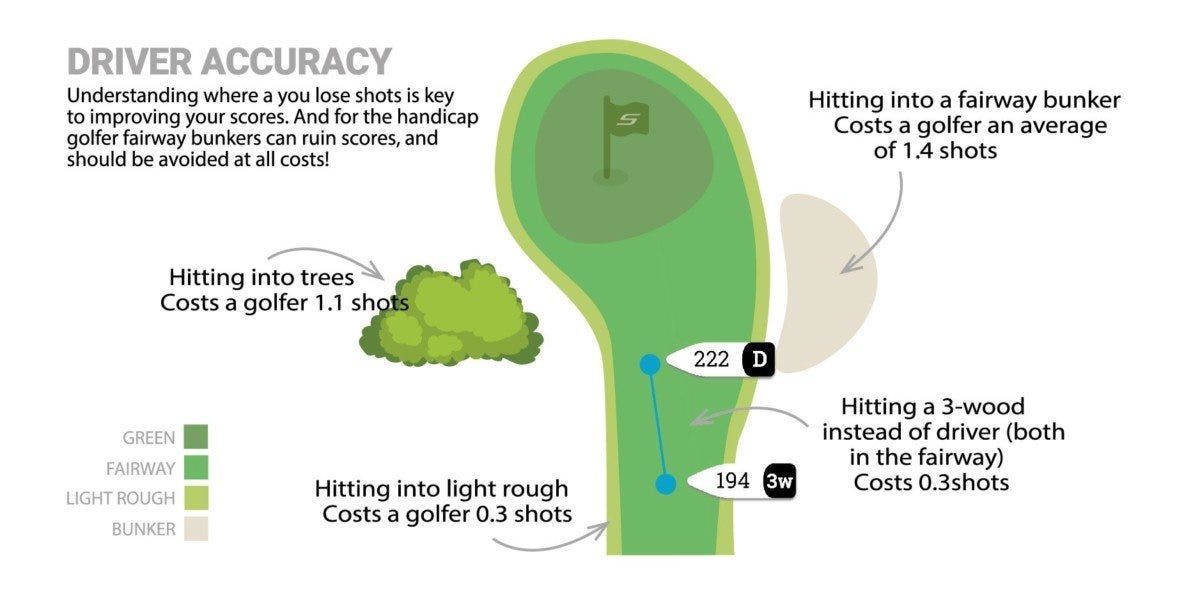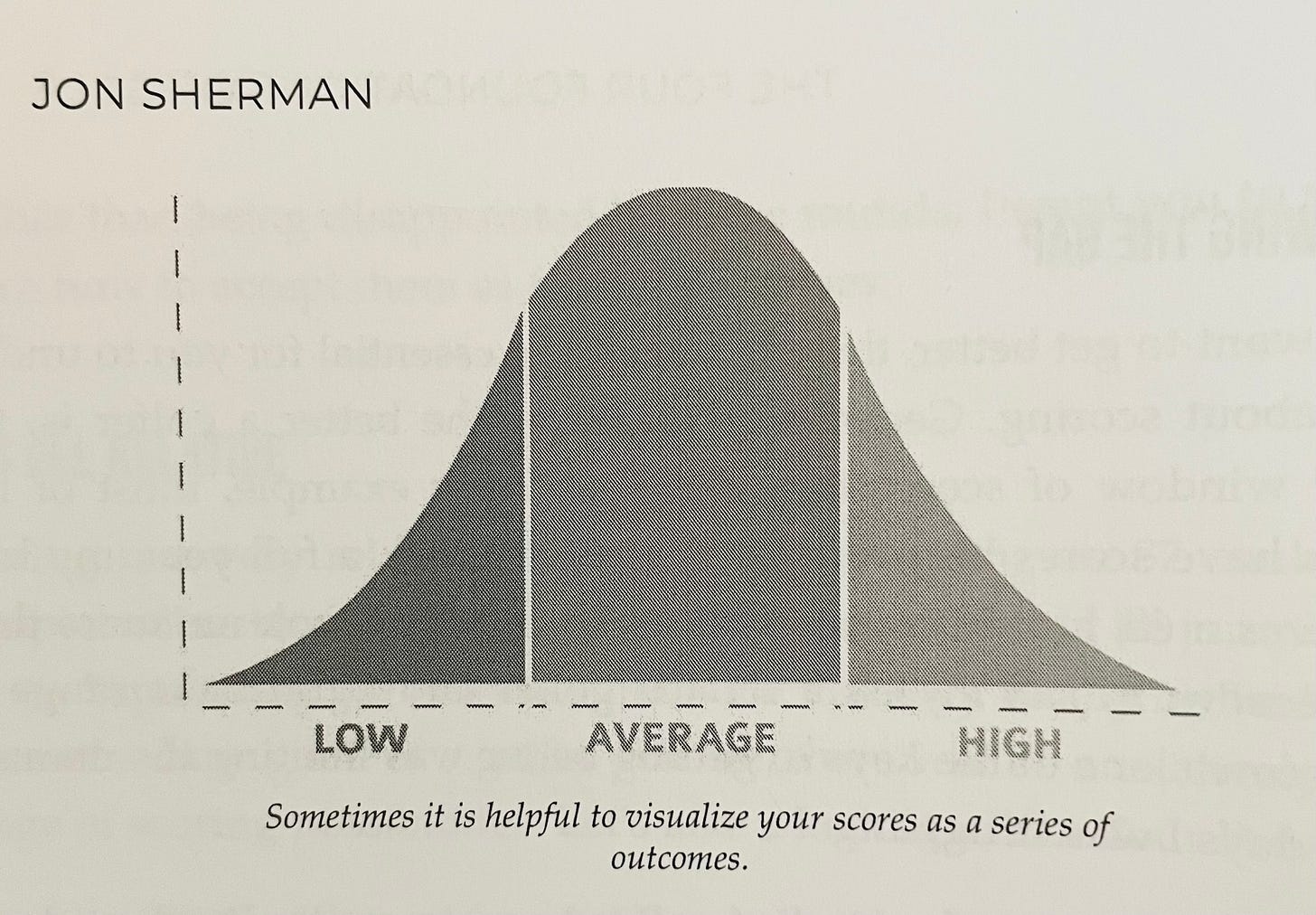It’s a little early for a greatest hits album, but we had a large influx of new subscribers, so I aggregated my favorite sections from past posts to get everyone caught up.
Have a great Labor Day weekend!
Putting Drills (link)
Training vs Playing (link)
Avoiding Double Bogeys (link)
Bunker Shots (link)
Avoiding Stupidity
“It’s remarkable how much long-term advantage people like us have gotten by trying to be consistently not stupid, instead of trying to be very intelligent.”
– Charlie Munger (link)
Good Strategy ≠ Good Results
“The correctness of a decision can’t be judged from the outcome.”
- Howard Marks (link)
The Next Shot
“I don't care how mad you get. Your head could blow off for all I care, just as long as you're 100 percent committed to the next shot."
-Tiger Woods to his son Charlie (link)
Newsletter #7: Accepting Scoring Variance (link)
It took me a long time to accept that my golf scores will fluctuate (a lot). Not every round can be great. Everyone including pros has scores that fluctuate, sometimes as much as 15 - 20 strokes. Why would we be any different?
Our scores are like a barbell curve with most of our scoring being within a certain range around our average. Outside of this first standard deviation, we start getting into lower-probability events (good or bad).
I’ll use myself as an example. In my last 10 rounds, I’ve averaged 81 strokes. My standard deviation is 4 strokes, which means about 70% of my rounds are between 77 and 85. That last 30% is either a really good round or a really bad round. It’s not going to happen that often, but it’s going to happen.
So what can we control? Over time we can tighten our variance. I don’t have the data but I used to have a much higher variance. This was generally due to the fact that when things weren’t clicking I would check out mentally, chalking it up to a lost round. I would lose focus, get frustrated, and start piling on triples and doubles.
My biggest problem was not matching expectations with reality. As Jon Sherman said, “[Golfers] go out hoping for their best scores. Additionally, they have a tough time accepting their higher scores.” By accepting the variability of golf I was better able to match my expectations with reality and in turn, stay more focused throughout a round.
We of course can lower our average score. This comes with practice and just getting better at golf. But no matter how good we get there will always be a variance! Don’t fight it. Accept it and you’ll play better golf.
I’ll leave you with a quote from Jon Sherman’s The Four Foundations of Golf:
“These ranges are a fundamental truth about the game. You are in control of shifting your scoring ranges and making them tighter, but no matter how good you get, these rules will still apply.”
Newsletter #2: Chipping vs. Putting (link)
There is not a round that goes by where I don’t see a fellow golfer that’s just off the green, walking up to the ball with a wedge in their hand. I cover my eyes in horror at what’s about to happen.
Just putt it! Fringe, fairway, light rough. If you are just off the green putting is almost always the best option for mid to higher handicap players.
Yes, there are exceptions to this and yes I’ve made this same mistake many times. Here are the stats from Lou Stagner himself:
In this example, a 10 handicap player averages the same amount of strokes to get it in the hole for a 5-yard chip as a 58-foot putt. As I said there are exceptions: bad lies, sprinkler heads, no path to the hole for a putt, etc., but by and large putting is going to win out on average.
The other exception is if you are close to a scratch golfer the calculus of chipping vs putting begins to narrow.
I think we make this mistake for a couple of reasons. One, hitting a good chip is just more satisfying. It’s impressive, it feels damn good when it works. Two, we overestimate the quality of our shots vs. the result of the shot.
This means that a so-called bad putt might FEEL bad, but very rarely does it leave you in much trouble. But a lousy chip could end up 2 inches in front of the original spot or skulled across the green into a bunker (or in the woods). Even a “good chip” we overestimate. It feels good and looks good, but we might be 10 feet short of the hole still being worse off than an average putt.
Newsletter #4: Base Rates (link)
“A base rate is basically a distribution of past experiences given the same set of initial circumstances. Just understanding how things have unfolded for other people can be very helpful to understand how things might unfold for you or your object of interest.”
-Michael Mauboussin
Hopefully, I didn’t lose you there. Simply said, base rates are:
The likelihood of something happening.
Luckily in golf, we have base rates for just about every type of shot and situation.
Sure we can’t remember them all. I certainly don’t. But I have a vague idea of various shots that I find myself in frequently. Knowing them loosely helps me align expectations with reality and keep calm.
Here are a few stats you can keep in mind to help you on the course:
Tee Shots

Forget fairways hit. Overrated. The goal off the tee is to stay out of trouble and hit it as far as you can while achieving goal #1. As you can see in the graphic, hazards like trees, bunkers, and obviously OB/Water cost golfers > 1 shot. But hitting it in the light rough is only .3 shots. As mentioned in Daily Divot: Finding Fairways, a top amateur golfer has a 70-yard dispersion left to right with the driver.
Lesson: You can have a GREAT round hitting very few fairways.
Putting
In a recent Daily Divot on 8-foot putts, I discussed how knowing the odds of making an 8-foot putt can be freeing for a golfer. A 90’s golfer makes 27% from 8 feet. “Tiger misses almost half of his putts from 8 feet! So give yourself some slack.”
Around the Green
A 10-handicap approach shot from 25 yards off the green will average just under 20 feet from the hole. The odds of getting “up and down” (1 shot, 1 putt) is 26%. So roughly 1 out of 4 times they will get up and down. A scratch golfer it’s still less than 2 out of 4 times.
Approach Shots
Check out this article by Lou Stagner with Golf.com. He compares 6 shots from Pros vs Amateurs. As you can see above, a Pro averages almost 20 feet from the hole from 100 yards. A 10-handicap averages 39 feet.
Keep these stats in mind next you golf. Knowing them can lead to better decision-making, but they can also let you better match expectations with reality and in turn keep your cool.
*If you want more info on golf base rates read The Four Foundations of Golf, The Lowest Score Wins or Every Shot Counts
Til next week.













